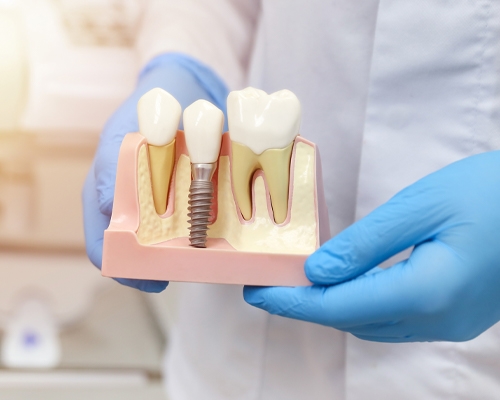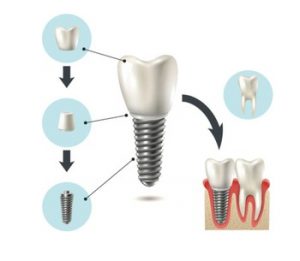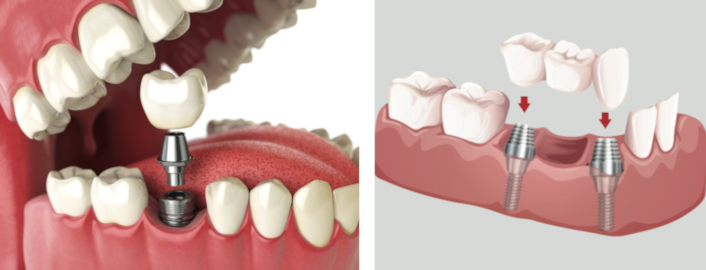
ODDZIAŁY
Description of the specialty
What is implantology?
IImplantology is a field of dental surgery that deals with dental implants used to replace missing teeth. It is treated separately from other specialties because dental implant procedures require exceptional precision both in terms of planning as well as implant placement.
What is a dental implant?
An implant is a small screw-like post of titanium or other alloys well tolerated by the human body. After placing in the mandible, it replaces the root of the missing tooth. A special abutment holds and supports e.g. the crown (the custom-made tooth). Therefore, the implant itself supports the crown, but it is not visible from the outside.
Did you know: Depending on the extent of the missing teeth, single crowns, bridges or even dentures can be placed on implants.

Implant treatment
Implant treatment makes it possible to replace various dental defects. It proves effective if you need to replace an isolated tooth, several teeth or even all teeth.
The dental implant procedure must be carefully planned, and the treatment plan supported by detailed diagnostics. Everything depends on the condition of the patient’s teeth, number of placed implants, and the selection of subsequent dental restorations. Your implant surgeon will give you all the information you need during your consultation appointment during which the doctor will perform relevant examinations and collect your medical history.
Did you know: At enel-med, we work with the best dental implant systems: Astra and Straumann.

When to visit an implantologist?
See an implantologist if you have dental defects and would like to replace them in a comfortable, permanent, functional and appealing way.
Implants are currently the best solution for restoring missing teeth. When placed in the bone, they replace your natural teeth and behave like natural teeth.
Implantology at enel-med
At enel-med dental practices, we offer a full range of implant treatments.
Learn more about our offer:
- Dental implant consultation
A consultation with a dental implant surgeon is necessary in order to plan the implant treatment. It is also an opportunity to ask any questions you might have. During the first consultation, the doctor will:
- collect detailed medical history in order to exclude any contraindications to the procedure;
- carry out physical examination and X-ray diagnostics to the extent necessary (orthopantomogram, CBCT);
- determine your health needs;
- suggest the optimum solution to your problems;
- prepare a schedule of subsequent visits and cost estimate of your treatment.
- Implant placement
The implant placement procedure takes 30 to 60 minutes, and is completely painless. It does not require a period of convalescence: it is enough that you take care of the wound after the procedure as per the doctor’s instructions, and appear at the specified time to have your stitches removed.
Bone augmentation
Single-tooth implant reconstruction
Single-tooth bridge
Preparatory procedures for implant placement
Preparatory procedures are performed only if the condition of the patient’s teeth does not permit immediate implant placement. Such situations include, for example:
- Sinus lift: maxillary sinus augmentation by lifting the lower sinus membrane and grafting extra bone (a bone graft) into the CNBC maxillary sinus. This procedure involves the maxilla, and is performed on the lingual side. It is necessary when there is not enough amount of the bone to place an implant because its atrophy has already started or for physiological reasons.
The sinus lift is performed under local anaesthesia during a single visit. - Bone graft: replacement of bone missing after loss of one or more teeth. The missing tissue is replaced with allograft or synthetic bone or bone harvested from the patient’s own body. Bone grafts are extremely precise, and it takes time to obtain a satisfactory result. The implanted material must fully integrate with the patient’s bone (osseointegration).
Stages of implant treatment
- Dental implant consultation: examination and X-ray diagnostics.
- Plan of treatment and prosthetic work, considering the patient’s health and aesthetic needs.
- Possible preparatory pre-implantation procedures, e.g. sinus lift, bone regeneration, bone grafting.
- Placement: placing a single dental post (implant). The procedure takes 30 to 60 minutes, and can be performed under local or general anaesthesia. It is usually painless, and causes no discomfort, but the doctor might recommend that you take antibiotics, anti-inflammatory medications or analgesics for a few days.
- Stitches removal at the check-up visit: 7 to 10 days after the procedure. The surgeon removes the stitches remaining after the procedure (cuts the sutures and pulls them out of the mucosa) to help the wound heal completely.
Exposure of the implant: 3 to 6 months after the procedure. Under local anaesthesia, the surgeon removes a small piece of the mucosa that covers the implant from the top. Later, a special abutment for attaching a crown, bridge or denture will be placed from this side, putting the so-called healing screw on (the inside of) the implant. The screw is meant to hold the space in the gum for e.g. the successive dental crown. This is the final surgical stage of the treatment. - Making impressions for further prosthetic work by a prosthodontist. From this point on, a prosthodontist takes over the patient. Depending on the type of prosthetic work performed, you need to arrange one or several visits.
- Fitting and/or delivery of the finished prosthetic work: the final part of the treatment.
- Possible adjustments and check-up visits: every 6 months or at other intervals recommended by your doctor.

FAQ
How to prepare for an appointment with an implantologist?
- Collect information about your health and write it down: your implant surgeon will certainly ask you about any diseases you have and about medications you take regularly.
- Think over your expectations and questions, and write them down: the specialist will be able to dispel all your doubts.
- Prepare for the diagnostics: orthopantomogram or CT scan, which are necessary to determine conditions for placing implants, select their size and number, and plan the initial dental restoration.
- Bring your test results with you: orthopantomogram or CT scan, even if they were taken a few years back.
What are the benefits of implant treatment?
- Replacement of missing teeth in a way that is aesthetically and functionally as close to the natural teeth as possible. Implant-supported crowns, bridges or dentures do not cause discomfort while eating, speaking or brushing teeth. Implant-supported dentures are not supported by the oral mucosa (like e.g. acrylic dentures), which significantly reduces the risk of atrophy of the maxilla and mandible.
- Natural smile: due to precise workmanship, all dental restorations ensure high aesthetic effect.
- Improved health: replacement of missing teeth prevents unpleasant conditions, such as bone atrophy, tilting or shifting teeth, tooth shift, tooth shifting from its sockets due to other lost teeth (the Godon phenomenon), overloading of the remaining teeth, overloading of the temporomandibular joints. These usually require very complicated treatment.
- Bone stimulation: due to the presence of the implant, chewing forces are transferred to the bone and begin to stimulate it. The bone receives the signal that it is needed again, which prevents tissue atrophy, common after tooth extraction.
Comfort of use:
- crowns and bridges are placed on implants, similar as in the case of your own teeth. They remain in the oral cavity permanently, and only require brushing and flossing, supplemented with the use of special floss and interdental brushes or a water flosser;
- implant-supported removable dentures (overdentures) require regular removal from the oral cavity and thorough cleaning, but – unlike conventional dentures – they have a firmer hold: they do not shift or fall out while eating, and cause practically no rubbing.
- Durability: enel-med’s implant suppliers offer a lifetime warranty for their products. Once inserted, the implant does not require any further surgical intervention, and the durability of the performed prosthetic work is estimated at around 10 years. The potential replacement of prosthetic work usually does not require implant replacement.
- No interference with other teeth: a single missing tooth is sometimes replaced with a dental bridge set on the patient’s other teeth. This requires removing some amount of the two adjacent teeth and making three connected crowns. In this situation, we are actually sacrificing two healthy teeth. This is not necessary in the case of an implant.
Consequences of non-treatment:
- atrophy of the alveolar process, i.e. the bony part of the mandible or the maxilla in which the teeth are anchored. This is a natural and irreversible process that occurs after tooth loss. In order to slow it down, an implant should replace the tooth as soon as possible;
- loosening and decay of teeth, caused by excessive abrasion, crushing and overloading of adjacent teeth;
- head and neck pain that prevent normal functioning, caused by overloading of the temporomandibular joint;
- shifting and tilting of the remaining teeth (this way, they compensate for the lack of the adjacent tooth);
- loss of a tooth adjacent to a missing tooth or difficulty adjusting a crown due to the Godon phenomenon. The Godon phenomenon involves the migration of a tooth situated opposite to a missing tooth (in the opposing arch);
- inflammation of the gums and the periodontium, common in overloads caused by transferring excessive chewing forces to a lower number of teeth;
- difficulty eating properly, indigestion, reflux disease: especially noticeable if you are missing a molar or premolar that have a large chewing surface and help break up the food;
- difficulty speaking, unclear speech: the teeth, especially the front teeth, are involved in the proper articulation – the tongue leans against them while speaking.
- problems in social situations, caused by unattractive appearance of teeth and visible gaps, preventing regular smiling.
Contact form
Please complete the form below. We will call you back, tell you about the details of the offer and arrange an appointment for you.



